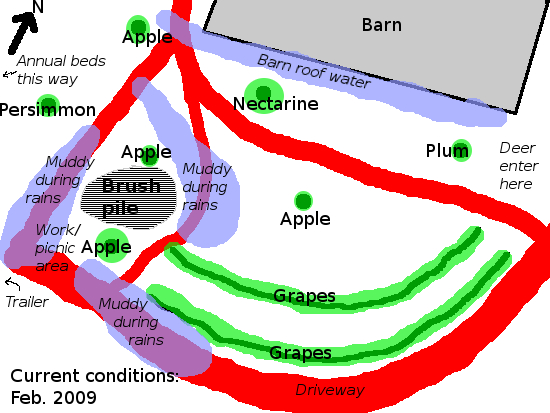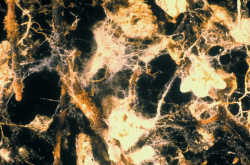
20090301perm2

The next step is to create a base map showing the current conditions at
the site. The area I'll be working with is bounded by the
driveway on the south, the barn on the north, and a major thoroughfare
on the west. Young fruit trees and grapevines are surrounded by
clay soil which ponds during rains. A three year old brush pile
is slowly rotting down, but is still a major feature of the
landscape. The site is mostly sunny, though the hill on the south
side shades it on winter mornings. We don't get any wind to speak
of back here in our holler.
 Biological problems include invasive
plants and deer browse. In addition, the book explains that in
areas dominated by grasses and herbs (like
meadows and old fields), the soil fauna is primarily bacteria.
Woody
plants --- which are what I want to promote in my orchard --- prefer
soil faunas which are instead dominated by fungi. So, I'll need
to
think about how to start to change my soil fauna to fungus
dominance.
Biological problems include invasive
plants and deer browse. In addition, the book explains that in
areas dominated by grasses and herbs (like
meadows and old fields), the soil fauna is primarily bacteria.
Woody
plants --- which are what I want to promote in my orchard --- prefer
soil faunas which are instead dominated by fungi. So, I'll need
to
think about how to start to change my soil fauna to fungus
dominance.
It all sounds like a tall order, but as the book explains, it's better
to turn a sick tract of land into a forest garden than start messing
around in a pristine forest where I'm more likely to do harm than
good. We can only go up from here!
| This post is part of our Planning The Forest Garden lunchtime series.
Read all of the entries: |
Want more in-depth information? Browse through our books.
Or explore more posts by date or by subject.
About us: Anna Hess and Mark Hamilton spent over a decade living self-sufficiently in the mountains of Virginia before moving north to start over from scratch in the foothills of Ohio. They've experimented with permaculture, no-till gardening, trailersteading, home-based microbusinesses and much more, writing about their adventures in both blogs and books.
Want to be notified when new comments are posted on this page? Click on the RSS button after you add a comment to subscribe to the comment feed, or simply check the box beside "email replies to me" while writing your comment.
